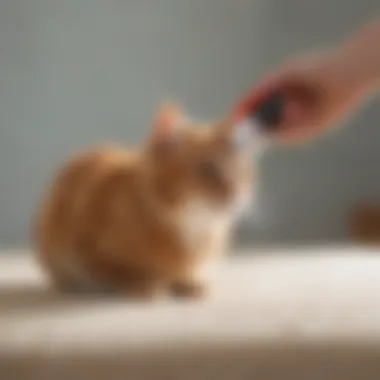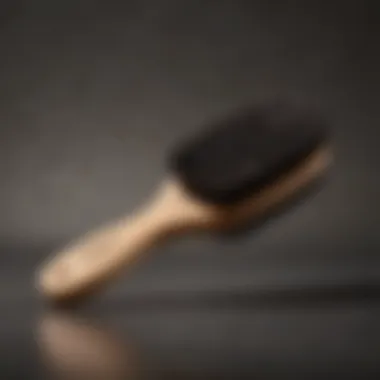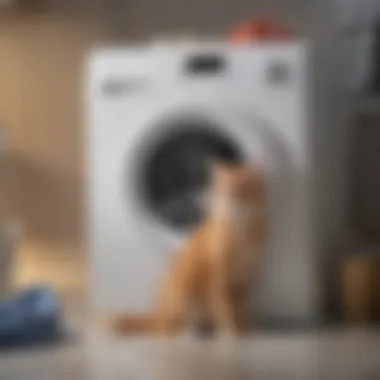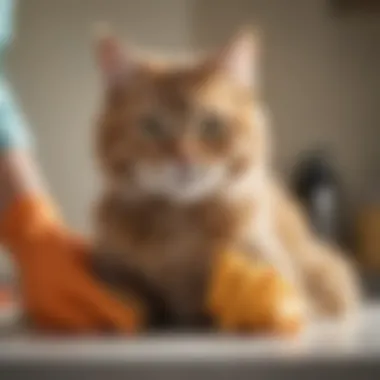Effective Strategies to Remove Cat Hair from Clothing


Intro
Cat hair can be a persistent problem for many cat owners. It clings to clothing, often appearing out of nowhere. This article presents effective strategies to tackle the challenge of removing cat hair from your garments. By understanding your options and employing suitable techniques, you can significantly reduce the amount of hair that makes it onto your clothing and enjoy a cleaner, more presentable appearance.
The methods described here range from preventative measures to immediate solutions. Each approach is tailored to different fabric types and situations, considering that some materials attract hair more than others. With practical advice and actionable tips, we aim to equip you with the knowledge to manage and eliminate this common issue effectively.
As we delve into details, we will highlight specific tools and techniques, providing clear guidance to help you navigate the various options available. Ultimately, understanding cat hair removal is vital for enhancing the quality of your clothing care regimen. By addressing this issue head-on, you can enjoy the companionship of your feline friend without compromising your wardrobe.
Understanding the Nature of Cat Hair
Understanding cat hair is crucial for effective removal strategies. Knowledge about its composition and behavior influences the way it interacts with clothing fabrics. This understanding lays the groundwork for implementing suitable cleaning methods and tools, making removal much easier.
The Composition of Cat Hair
Cat hair is primarily made of keratin, a fibrous protein that provides structure and resilience. This composition allows for flexibility and durability, which means cat hair can withstand regular wear and tear. Cats shed hair as part of their natural lifecycle, with seasonal changes increasing shedding frequency.
It is important for cat owners to note that each breed has different types of hair. For example, Siamese cats have fine hair, while Maine Coons have thicker, longer fur. These variations affect how hair clings to clothing and other surfaces. In addition to the hair itself, cat dander, a common allergen, often accompanies loose hair, intensifying the issue for sensitive individuals.
Why Cat Hair Sticks to Clothing
Cat hair's ability to cling to clothing can be attributed to several factors. Firstly, the small diameter of individual hair strands allows them to easily embed in fabric fibers. The scale-like texture on cat hair increases friction, effectively giving it a grip on various materials.
Materials such as cotton and polyester are particularly prone to attracting cat hair. Their textures allow for the easy entrapment of stray hairs.
Additionally, static electricity plays a role in this situation. When clothes rub against one another, they may generate static charge, which can make hair stick more firmly to the fabric. Being aware of these properties can inform strategies to prevent and remove cat hair, leading to a more effective approach to clothing care.
Preventative Strategies
Preventing cat hair from accumulating on clothing is an effective method to manage this common issue. Not only does it save time and effort during cleaning, but it also enhances the overall quality of life for cat owners. By taking proactive steps, individuals can reduce the frequency with which they need to remove hair from their garments. This section discusses two specific strategies that can make a significant difference.
Choosing Cat-Friendly Fabrics
Selecting the right fabrics is crucial for any cat owner. Certain materials tend to attract less hair compared to others. For instance, smooth and tightly woven fabrics such as polyester or nylon are less likely to hold onto cat hair than fuzzy fabrics like wool or velvet. When shopping for new clothing, it is wise to consider these factors.
Opting for garments made of synthetic materials can be beneficial. Not only do they resist hair, but they are also typically easier to clean. Furthermore, avoiding fabrics that tend to generate static electricity can also help reduce hair clinging to clothing. Static can create an attractive force, which causes hair to stick stubbornly to fabric surfaces. Thus, prioritizing cat-friendly clothes can lead to a notable decrease in stray feline hair on clothing.
Establishing a Pet-Free Zone
Creating designated pet-free areas in the home can significantly minimize the amount of cat hair that transfer onto clothing. This involves setting aside specific rooms or zones where pets are not allowed. For instance, keeping bedrooms and dedicated workspaces free of cats ensures that clothing stays cleaner and hair-free.
Enforcing these zones may require training and establishing boundaries with your cat. It may take time, but positive reinforcement can aid in making cats comfortable with the idea of staying out of certain areas. Additionally, an environment with less clutter can help reduce the accumulation of hair and make cleaning easier.
Having these strategies in place transforms not only the physical space but also contributes to a tidier life for cat owners. Implementing these methods can result in measurable benefits in reducing the amount of cat hair on clothing.


Tools for Hair Removal
Removing cat hair from clothes demands specific tools designed for efficiency and ease of use. The right supplies not only streamline the cleaning process but also enhance the overall effectiveness of hair removal methods. With numerous options available, understanding each tool's advantages and optimal use is essential for pet owners facing this common challenge. The following sections provide insights into various tools that can be employed to combat the persistent problem of cat hair on clothing.
Lint Rollers and Adhesive Sheets
Lint rollers are among the most popular choices for quick and effective hair removal. These devices typically consist of a handle and a roll of adhesive sheets that capture hair, lint, and debris as they are rolled over fabric surfaces. One of the key benefits of lint rollers is their portability; they are easy to carry, making them ideal for use at home or on the go.
- Efficiency: Lint rollers can capture significant amounts of hair in a short amount of time.
- Versatility: They can be used on various clothing materials and soft furnishings.
- Replacement Sheets: It’s important to ensure you have enough adhesive sheets on hand as they are single-use once the surface is full.
While very useful, lint rollers may not be enough for stubborn or large clumps of fur. It is helpful to apply gentle pressure to enhance their effectiveness. When selecting a lint roller, consider the size—larger rollers may cover more area, but a smaller one can be more maneuverable.
Rubber Gloves and Brush Techniques
Rubber gloves can serve as a surprisingly effective tool in your cat hair removal arsenal. By simply wearing rubber gloves and dampening them slightly, you can gather hair by running your hands over clothing. The friction created between the rubber and the fabric lifts the hair, which then sticks to the glove. This technique can be particularly useful on furniture too.
- Cost-Effective: Rubber gloves are generally inexpensive and readily available.
- Multipurpose: Besides hair, they can also help remove dust and lint from fabrics and surfaces.
- Eco-Friendly: Using gloves reduces waste compared to adhesive products that are disposable.
Using a brush can enhance this technique. Gently brushing the fabric with the rubber glove-covered hand can increase hair pickup efficiency. Ensure the gloves are clean before use to avoid transferring any dirt back onto clothing.
Specialty Pet Hair Removal Tools
Dedicated pet hair removal tools have emerged in response to the unique challenges posed by pet hair. These tools are purpose-designed to tackle the issue more effectively than conventional tools. Options include rubber brushes, grooming tools, and vacuum attachments that specifically target pet hair.
- Rubber Brushes: These brushes attract hair easily and can be used on various surfaces. They also work well on carpets and upholstery.
- Grooming Tools: Regularly grooming your cat with special brushes can reduce the amount of loose fur that ends up on clothing.
- Vacuum Attachments: Many vacuums now come with attachments tailored for pet hair removal, making deep cleaning more effective.
When selecting specialty tools, consider their compatibility with your cat's fur type and your fabric choices. Experimenting with different ones may help find the best solution for your needs. Utilizing these specialized tools can turn an arduous chore into a manageable task.
Cleaning Techniques for Different Fabrics
In the context of managing cat hair on clothing, understanding cleaning techniques tailored to different fabrics becomes essential. Each type of material has unique properties that make it susceptible to hair accumulation in distinct ways. By applying informed strategies tailored to specific fabrics, cat owners can effectively minimize the persistence of fur. This not only enhances the longevity of the garments but also maintains their aesthetic appeal.
Removing Hair from Cotton and Natural Fibers
Cotton and other natural fibers are often favored for their breathability and comfort. However, these fabrics have a tendency to attract cat hair quite easily. When tackling hair on cotton, consider the following steps:
- Use Adhesive Rollers: Lint rollers or adhesive sheets are effective tools. Lightly roll the adhesive over the fabric to lift hair without damaging the fibers.
- Brush with Soft Bristles: A gentle brush can help dislodge hair before washing. Brush in one direction to avoid fraying.
- Washing Techniques: To further reduce hair buildup, wash these fabrics with an extra rinse cycle. This helps flush away trapped hair.
Taking these actions helps maintain the appearance of cotton garments while ensuring that cat hair does not become a recurring issue.
Tackling Synthetic Materials
Synthetic fabrics like polyester and nylon often have a slick surface that can either trap hair or allow it to slide off easily. For these materials, a few specific techniques can be effective:
- Dryer Sheet Method: Toss a dryer sheet in the dryer before washing. This can reduce static cling, making it easier for hair to detach during the cycle.
- Static Removal: For items still containing hair after washing, try using an anti-static spray. This creates a barrier that makes it easier to brush off stray hairs.
- Use a Damp Cloth: Wiping down synthetic clothing with a slightly damp cloth can help collect hairs that resist removal. The static charge of the fabric can also attract the moisture, catching the hair effectively.


These techniques can enhance the upkeep of synthetic materials, ensuring they are keep clean and free from excessive pet hair.
Special Considerations for Sensitive Fabrics
Sensitive fabrics such as silk, lace, or delicate knits require special attention. Their fragility necessitates careful handling to avoid damage while addressing cat hair:
- Gentle Lifting: Use your fingers or a soft brush to gently lift hair away. Avoid aggressive scrubbing which may harm the fabric.
- Hand Washing: If washing is needed, hand wash using cold water and a mild detergent. This reduces the risk of hair entanglement.
- Storage Solutions: Consider storing sensitive items in breathable garment bags. This minimizes exposure to hair accumulation and protects against potential snags.
Following these considerations helps ensure that delicate fabrics remain undamaged while remaining cat-hair free.
Home Remedies and Alternatives
In the pursuit of clean clothing free from cat hair, home remedies and alternatives serve as practical and often cost-effective solutions. These methods can be particularly useful for pet owners who seek immediate fixes using what they already have at home. The advantages include accessibility, eco-friendliness, and the ability to use common household items without the need for specialized equipment. By employing these strategies, it is possible to manage and reduce cat hair on clothing without undue stress or expense.
Using Sticky Tape
Sticky tape is a simple yet effective method for removing cat hair from clothing. Duct tape, packing tape, or even tape designed for lint removal can work well. The process is straightforward: take a piece of tape and wrap it around your hand, sticky side out. Then, gently press the tape onto the fabric and lift it away. The hairs adhere to the tape, leaving your garments cleaner with minimal effort.
Sticky tape eliminates hair quickly and can be used anytime, making it a reliable choice for unexpected outings.
While this method is highly effective for small areas or quick touch-ups, it's important to note that it may not be suitable for larger articles of clothing or heavy shedding sessions. Always test on a small, inconspicuous area first to ensure the tape won't damage the fabric.
Vinegar and Water Solutions
Vinegar mixed with water is another popular home remedy for pet hair removal. When added to laundry, vinegar can help break down hair, making it easier for the washing machine to lift. Mix one cup of white vinegar with a quart of water in a spray bottle. Spray the solution lightly on your clothing before washing. This not only aids in loosening hair, but it also helps eliminate odors, providing additional benefits for pet owners.
Once the spraying is done, toss the item into the washing machine. Select a gentle cycle with cold water to protect the fabric. This method is effective for various fabric types, ensuring a thorough clean while being gentle on sensitive materials.
Both of these strategies highlight how effective home remedies can be in addressing the nuisance of cat hair. By integrating them into a regular cleaning routine, pet owners can maintain a cleaner wardrobe with ease.
Washing and Care Instructions
In the battle against cat hair, washing and care instructions hold significant importance. Proper handling of the garments before and during the laundry process can mean the difference between effectively removing hair and merely redistributing it. To manage cat hair on clothing effectively, one must understand how to prepare items for washing and how to select the appropriate settings on washing machines.
Pre-Treatment Before Laundry
Before loading your clothing into the washing machine, it is wise to prepare them for the best results. Pre-treatment is essential for removing as much hair as possible. Here are some effective methods:
- Shake and tumble: Take each garment outside and give it a good shake to dislodge hair. A brisk movement helps release loose fur.
- Use a lint roller: Apply a lint roller to the fabric before washing. The sticky sheets grab hair efficiently and are especially useful for larger areas.
- Damp cloth method: Lightly dampen a cloth and wipe the surface of the clothing before washing. This helps lift hair off the fabric.
Pre-treatment can significantly reduce the amount of cat hair that enters the washing machine, which aids in cleaner results.
Choosing the Right Laundry Settings
Selecting the suitable laundry settings is crucial for effective hair removal. A few factors influence the choice of machine settings:


- Water temperature: Opt for warm water, as it helps loosen hair from fibers better than cold water, while also being safe for most washable fabrics. Hot water is usually not recommended, as it can shrink some materials.
- Wash cycle: Consider using a longer or more intense wash cycle, especially for heavily soiled items. A standard cycle may not be enough to adequately dislodge hair from clothing.
- Load size: Avoid overloading the washing machine. A smaller load allows for better movement, resulting in improved hair removal from the fabric.
Proper settings on the washing machine can enhance the cleaning process, reducing the hair left behind significantly.
Drying Techniques to Reduce Hair
The drying phase can also play a critical role in how much cat hair remains on clothing. Implementing specific techniques can help minimize hair fallout:
- Use dryer balls: Adding dryer balls during the drying process can agitate the fabric, which helps loosen remaining hair. This is an efficient method to reduce pet hair.
- Air dry option: Consider air drying garments when possible. The static created in the dryer often leads to hair adhering to the fabric more stubbornly.
- Clean the lint trap: Always make sure to clean the lint trap before and after drying. A clogged lint trap can trap fur and reduce the efficiency of hair removal.
Maintaining a clean and efficient drying process is necessary for keeping garments free of cat hair.
Remember, while removing cat hair from clothes can be a challenge, the combination of pre-treatment, appropriate laundry settings, and effective drying techniques can produce positive results.
Maintaining Clean Clothes Over Time
Maintaining clean clothes over time is crucial for cat owners who wish to manage the persistent presence of cat hair in their wardrobe. Regular care helps to prevent the buildup of fur on fabrics, ultimately reducing the frequency and intensity of cleaning required. By adopting specific practices, pet owners can enjoy a cleaner wardrobe while prioritizing the comfort of their pets. This section will explore two essential strategies: regular grooming of pets and establishing a cleaning routine.
Regular Grooming of Pets
Regular grooming of pets is one of the most effective measures to control cat hair around the home. Brushing your cat often helps to remove loose hair before it can settle on clothing or furniture. Different breeds may require different grooming frequencies, but generally, a thorough brush every few days is adequate for most cats. Using specialized tools, such as slicker brushes or grooming gloves, can significantly enhance the effectiveness of this process. These tools capture the hair effectively and reduce the amount that ends up in your living space.
Moreover, regular grooming is not just about hair removal. It also contributes to the overall health of your pet. Grooming stimulates the skin and helps distribute natural oils, promoting a shiny coat.
Establishing a Cleaning Routine
An effective cleaning routine is integral to maintaining clothes free from cat hair. First, consider integrating a daily habit of lint rolling or using a rubber glove on clothes before wearing them. This quick action prevents hairs from being carried out of the house.
Next, choosing a specific day for more extensive cleaning can contribute to hair management. Allocate time each week for washing clothing, bedding, and soft furnishings. Make it a point to wash items like blankets or throws that your cat favors, as these are often prime locations for hair accumulation.
Utilizing the right washing and drying settings can also minimize hair retention and improve cleanliness. For example, a shorter wash cycle with cold water and using dryer balls during drying can help loosen hair from fabric.
Incorporating these practices will not only simplify the task of managing cat hair but also enhance the welfare of your pet.
By implementing regular grooming and establishing a cleaning routine, cat owners can effectively maintain their clothing. This proactive approach minimizes the impact of cat hair on daily life, allowing pet owners to enjoy their feline companions without sacrificing the cleanliness of their wardrobe.
Epilogue
The challenge of removing cat hair from clothing is one that many pet owners face regularly. This article aims to provide insightful solutions that go beyond temporary fixes, allowing readers to manage and minimize the presence of cat hair effectively. Understanding the nature of cat hair, utilizing the right tools, and applying proper washing and maintenance techniques are crucial elements in ensuring clean clothing.
Summary of Key Strategies
- Preventative Measures: Protecting clothing from cat hair is often easier than removing it. Choosing cat-friendly fabrics and establishing pet-free zones can significantly reduce the amount of hair that ends up on clothes.
- Utilizing the Right Tools: Tools such as lint rollers, rubber gloves, and specialty pet hair removers have proven effective. Knowing the right tool for the task can make the removal process smoother and faster.
- Appropriate Cleaning Techniques: Different fabrics require tailored approaches for effective hair removal. Knowing how to treat each type of material properly can prevent damage and ensure optimal cleaning results.
- Washing and Care: Applying pre-treatment solutions, selecting the right laundry settings, and employing the correct drying techniques all contribute to hair-free clothing after washing.
- Regular Maintenance: Consistent grooming of pets and establishing a cleaning routine can make a significant difference in the long-term management of cat hair on clothing.
Final Thoughts on Cat Hair Management
Successfully managing cat hair on clothing is about prevention, effective removal techniques, and maintaining a consistent routine. As cat owners implement these strategies, they may find that the frequency and visibility of cat hair on their clothing decrease significantly. This not only improves the appearance of clothes but also enhances the overall maintenance of a pet-friendly home. Finding balance between enjoying the companionship of a cat and maintaining a clean wardrobe is undoubtedly achievable when equipped with the right knowledge and tools.
Investing time in understanding these strategies not only simplifies the task of removing cat hair but also contributes to better living environments for both pets and their owners.
By addressing cat hair management with strategic intent, readers are empowered to enjoy their companionship without the constant worry of fur-covered clothing.















